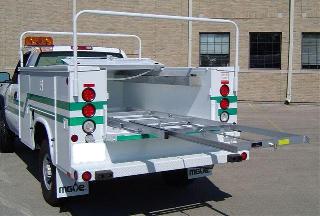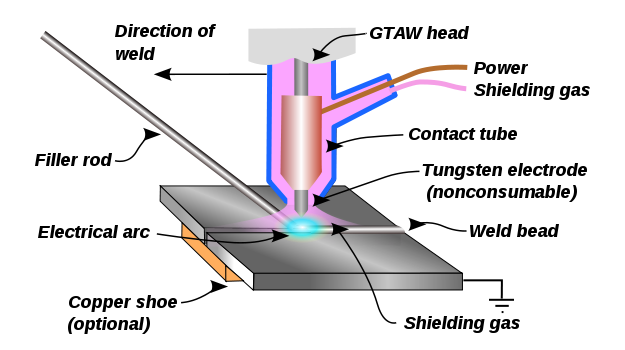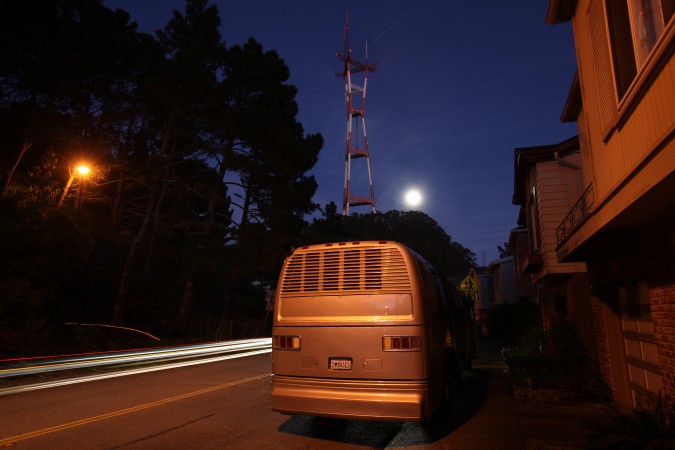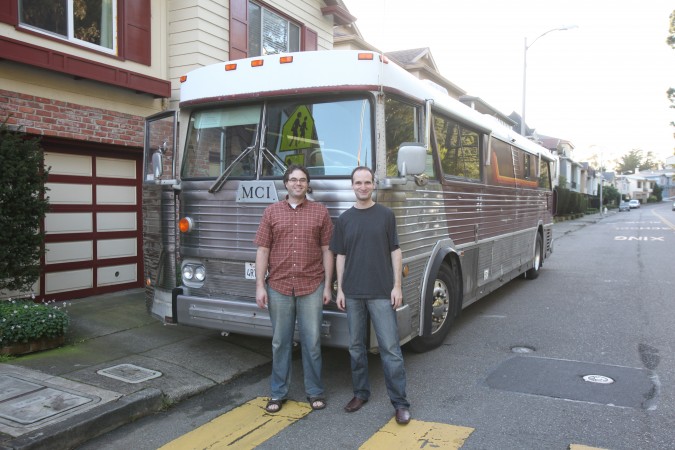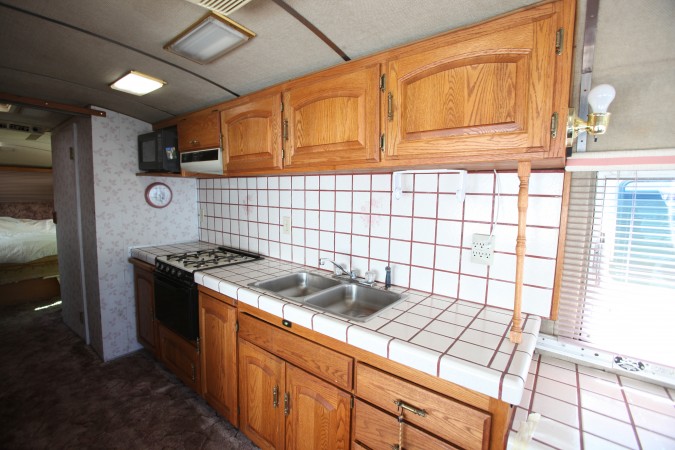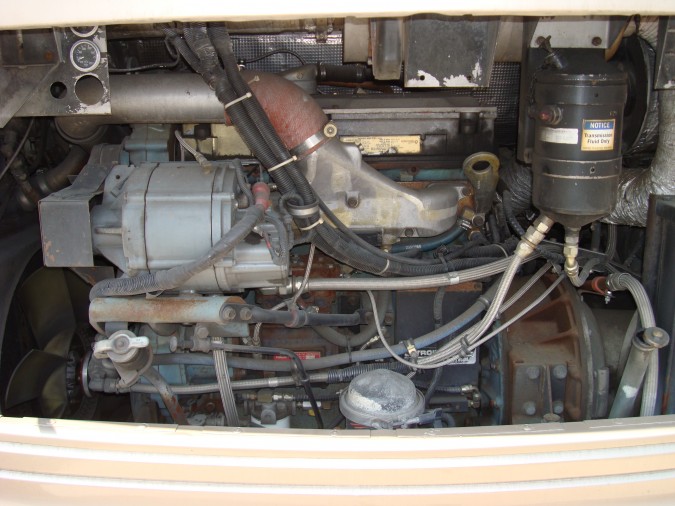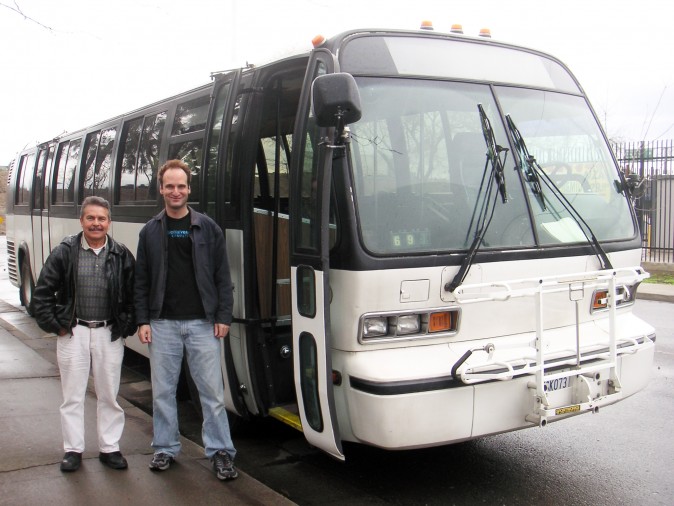Archive for the ‘Bus conversions’ Category
Slide out solar panels for my bus conversion
For a while now I’ve been thinking about putting solar hot water and solar photovoltaic panels on slide out mechanisms on the roof of my RTS bus conversion.
Today I found a supplier that would make this plan easy to implement.
I imagine that when camped I could push a button and solar panels could extend from the street and curb side of the conversion.
There would be the primary panels about a foot over the top of the roof, flush with the top of the roof deck shroud I’m planning. The extra panels would be under the primary set, and these are the panels that would slide out.
At first I thought I would use stainless steel heavy duty drawer slides for this project, but they are very costly and would require that I build a frame to use them with. Then, on YouTube, I found the solution: Glide N Grab
This company makes slide out platforms for pickup trucks, work vehicles and RVs. The platforms are available made from aluminum, which I like for weight savings and corrosion resistance. The aluminum slides are available in capacities up to 1,000 pounds. Photovoltaic panels weigh about 50 pounds, and I probably could fit two at once on one of these slide out platforms. That would leave unused capacity of 900 pounds to battle the forces of the wind, which could be ferocious. The Glide and Grab company even sells a motorized extend and retract option, so I wouldn’t have to build something special.
These slides are quite affordable compared to drawer slides, and I think they’re much more suited to the task. I probably won’t implement this plan for years, as I still have so much work to do, and I’m busy with work and my urban homestead. But I wanted to write about this today as I am really excited about this idea. For bus converters where money is of little object, these slides are cheap, and if you covered the roof of a $2,000,000 Prevost with panels and slide out panels on the street and curb side, that’s probably enough power to run an air conditioner to keep 1/4 or a 1/3rd of the vehicle cool without running a generator. This would be a green selling point, and it would certainly be a conversation starter in the high end resorts where the owners of these vehicles vacation. These 45 foot monsters could be segmented with doors or curtains so the entire vehicle doesn’t need to be cooled at once.
If I build shipping container houses, these slides make sense, since a key goal is to not need grid electricity. For extreme climates, the area on the roof of a container may not be large enough to generate all the energy needed. With these Glide N Grab slides, one can at least triple the solar capture area. I suspect that the slide area does not count as ‘projected roof area’ when building codes are applied, since the panels can be retracted each day when the sun goes down or during severe winds. Using slides on the roof of a shipping container house would also allow more of the roof of the container itself to be used for food production, increasing the potential for self sufficiency.
This idea is certainly less adventuresome than the idea of making entire rooms slide out of an RV or bus conversion, which must have seemed crazy when first proposed. Room slides caught on, and even inexpensive RVs and travel trailers now offer them.
I see no reason why solar hot water heating panels can’t be placed on these Glide N Grab slides, though perhaps the heavier duty steel slides would have to be used, and special water tubing would have to be used that is both flexible and resistant to ultraviolet radiation.
If you implement this sliding solar panel plan before I do, please send me some pictures.
I suspect someone has already thought of this idea and has implemented it. I couldn’t find any references after a brief search online. If you know of a writeup that predates this one, please add a comment to this post. Thank you!
Should I add wings to my RTS bus conversion?
I wonder if I can make by RTS bus conversion fly? After all, this guy got his school bus to fly!
I took the metal shop safety and basic use class at Techshop

Grizzley brand planishing hammer
I completed the metal shop safety and basic use class at TechShop yesterday, February 1, 2011. This was supposed to be a two hour class, but the instructor stayed late on his own time to make it almost a four hour class! The instructor was outstanding, and I recommend this class.
I learned to use the powered slip roll machine, the metal brake, a cutoff saw, the metal shear, the horizontal band saw, the vertical band saw, the air planishing hammer, the English wheel, the metal shrinking and stretching machines and a machine that puts a rib into metal.
I was most impressed with the slip roll machine and the planishing hammer. I now know how I’ll bend the aluminum for the ceiling in my RTS bus conversion. I had planned to not bend the aluminum and just select material that was thin enough to bend during installation. I was going to count on screws to hold the bended shape. But it will be so much better to apply the bend in the slip roll machine. I may even be able to use industrial Velcro to hold up the ceiling panels if they are pre bent. This will mean fewer screws, which would make it easier to get behind the panels if I need to.
I welded for the first time
Yesterday, January 30th, 2011, I took a class in TIG welding at TechShop in San Francisco, California. This was the first time I have done any kind of welding. The class was short, at under two hours, so all we had time to learn to do was prepare our torches and practice welding a bead on a blank piece of common steel. Even though this may not seem like anything, it eliminated my fear of arc welding. What astonished me is how quiet TIG welding is. It’s nothing like MIG welding that produces an intense and somewhat nerve wracking ‘welding’ type sound.
TechShop has gotten some nice press, and they had some nice flyers out at the front desk. Here’s an article from CNNmoney.com entitled TechShop: A blowtorch-filled paradise for inventors. Here’s an article from the San Francisco Chronicle entitled Inventor’s need for tools sparked TechShop.
I’m now going to sign up for the aluminum TIG welding class.
Plan for generating electricity cheaply and quietly on recreational vehicles
As you know, I am in the process of reconverting my RTS bus conversion. I did a minimum conversion in order to legally title it as a motorhome in California. The California Department of Motor Vehicles inspected and signed off on the conversion and changed the title to ‘automobile housecar.’ This entitled me to register and insure it as a motorhome, which costs less than a passenger bus to insure. I had to do this conversion quickly, and I didn’t have the time to create the type of vehicle I really wanted. I sold my old MCI bus conversion recently, and that gave me the funds to redo aspects of my RTS conversion.
One of the most severe problem with my first conversion of the RTS was that I didn’t insulate it. I left the existing insulation in the walls and ceiling. That insulation was fiberglass encased in plastic wrap. It was thin and not particularly effective. I’ve since discarded this insulation and have received a written quote from Tri County Insulation in Santa Clara, California some time back now. I couldn’t have the work done because I didn’t have the money at the time. Now I do, thanks to selling my MCI conversion. I’m back in touch with Tri County and they still want to do the work. I hope to get the RTS spray foamed in the next week or so, if all goes well.
One of the other problems with my RTS is it did not have a generator. It has installed a powerful Trace SW4024 inverter with a bank of Trojan T105 batteries. This system can power up to 4,000 watts of AC appliances at once. It’s a true powerhouse. It’s discontinued now as I’ve had it since 2001, but you can still get them on EBay, and it’s still considered the gold standard of inverters for bus conversions.
I’ve thought a lot about what kind of generator to install in my RTS, and this article details my plans.
The normal way bus nuts handle generator power is to put a 5,000 to 20,000 watt diesel generator in a storage bay. This can cost $5,000 or more, and these monsters weigh perhaps 400 pounds and consume half a gallon of diesel per hour, which is way too much for a modern future oriented vehicle.
What I have in mind is a propane engine driving a large frame 24 volt alternator. The 24 volts DC would be routed through the Trace SW4024 inverter I mentioned above, and this would give me up to 4,000 watts of AC power. This inverter can sustain that output continuously if it is ventilated enough to keep it cool. I don’t forsee any situation where I would need to push it to the limit full time however.
I want to use propane because the emissions are cleaner, and the fuel is easier and safer to handle than gasoline. It’s also cheaper, in part because road tax is not added to the price per gallon. But another huge benefit is that propane doesn’t go bad like gasoline does, so the generator stays cleaner and is easier to start after long periods of non use. Gas generators are notorious for getting gummed up with stale fuel and being hard to start if not used frequently enough. I already converted my Honda eu1000 generator to propane using a kit from US Carburation Kit Center, which sells kits for numerous generators and engines. You send them the carburator from your engine, and they modify it and plumb it to accept propane. Then you reinstall it on your engine and hook up a source of regulated propane and your gasoline engine now runs on propane. It’s simple.
The discount tool store Harbor Freight sells gasoline engines for unbelievably low prices. For example, with a 20% off discount coupon one can always find online or in some print magazines, an electric start 11 horsepower gasoline engine can be purchased for under $300 including sales tax! This is a fantastic deal. One could buy a spare to keep on board for on the road replacement if something went wrong with the primary engine.
My idea is to use a big enough alternator to take full advantage of the 11 horsepower output, but to choose pulleys so that even when the engine is running at idle speed that useful DC power is produced. This may take more than one pulley, like in a drill press, where the operator can change the speed by manually grabbing the stopped V-belt and putting it on a different pair of pulleys.
These Harbor Freight engines run at 3,600 RPM at full output, but their idle RPM is much lower – I would guess around 1,800 RPM. I predict that the noise output drops dramatically at idle, like the Honda EU series of Inverter based portable AC generators. I’m sure the fuel use drops dramatically as well. I suspect that even at idle an 11 horsepower engine can produce at least 3 horsepower. This is around 1,000 watts of power when converted through an alternator and inverter to AC. This is enough power to run a mini-split 9000 BTU air conditioner. If I need more power, I can just adjust the engine throttle to run the engine faster, and more power will come out. I should be able to rig up a remote throttle control so I could change the engine speed from inside.
One of the main reasons bus nuts go with huge diesel generators is the big ones usually run at 1,800 RPM and are water cooled. By running an 11 horsepower generator at idle, I hope to get to the 1,800 RPM speed. Now I need to make the generator water cooled… but how?
When I was thinking up my efficient motorhome air conditioning idea, I discovered how inexpensive car radiators can be. They can be had for under $100 each for smaller ones. Even the smallest should be fine for my application, as cars have engines much larger than 11 horsepower.
My idea is to build a soundproof box for the engine, and put a car radiator inside the box with the radiator fins directly in the path of the airflow from the engine fan. Then, connect this radiator via rubber radiator hose to a second radiator outside the box, which could be close to or far from the box, as needed. An electric fan mounted on this outside radiator would send air over the fins to cool them. A water pump would circulate water between the two radiators, and this pump would be powered directly by the starting battery for the engine, which is constantly charged by the built in alternator on the engine which keeps the starting battery fully charged. So, the pump would only run when the engine is running, which is what the plan requires.
The dual radiator system will make the generator system quiet because the generator box no longer needs a large fresh air source, so the box can be sealed and insulated, except for a small pipe to provide combustion air and a small pipe for the combustion exhaust. The area of these two pipes should be under 2 square inches. This is almost nothing compared to how much area would be needed to directly air cool an 11 horsepower engine.
Another huge benefit to my proposed system is that the box can be custom fit to just contain the engine and radiator. This won’t take much space compared to building box for an air cooled generator, which would need multiple sound baffles and sound foam in the baffles to quiet the noise. With my design, I predict the volume required is 1/2 to 1/3 what would be required otherwise.
Since the air in and exhaust out portals are so small, it will be difficult for any engine fire to cause catastrophe, because an engine fire couldn’t get unlimited oxygen to burn. It will be a simple matter to build a trap door for these inputs and outputs that will snap shut if there is a fire, and with no oxygen, the fire will go out almost immediately. Many RVs and bus conversions burn to the ground when a generator catches fire, so my proposed system will save money and lives if widely adopted by others.
The trap doors I envision would be spring loaded, and held open with meltable links that would melt and come apart if they get too hot, as they would in an engine fire. This kind of trap door is used in HVAC systems to slow the spread of fire in buildings, so the technology is proven and cheap.
For extra safety, a propane detector can be installed that is linked to a gas shutoff valve. When the detector senses propane, the shutoff valve loses electricity, and since it’s spring loaded as well, it closes and shuts off the flow of propane. An engine without propane or oxygen won’t burn for long.
Now that I’m a TechShop member, I have access to a metal shear and bending brake. A shear will cut sheet metal like scissors cut paper. A bending brake will bend sheet metal. Thus, I can make the engine box out of steel or aluminum, for added fire safety. I am taking a class in TIG welding at Techshop on January 24, 2010, so I hope to be able to weld the box seems to be certain the box can be tight enough to stop a fire.
I’m thinking about mounting the generator I describe here on the roof deck I envision for my RTS, over the driver’s compartment. The inverter is now installed in the back of the RTS, but I have built a special compartment in the front stairwell, under the passenger seat. I did this because large inverters hum when on, and I want that noise as far from the bedrooms as possible. My RTS has two bed areas, one mid ship and one in the rear. So if the inverter is in the front stairwell area, with two residential doors separating it from the closest bed area, I don’t think anyone will be able to hear the inverter, even if parked in a quiet spot. I need to check the RV code book to see if there is a restriction to roof mounting generators. I don’t suspect that there is one, but I want to do things correctly. The big benefit to roof mounting is the engine will be outside the living area, so I can just direct the exhaust out of the box into the atmostphere, without having to worry about the safety concerns of running exhaust pipes through or underneath living areas.
I’ve thought about the above generator concept quite a bit, and I like the idea. It’s more efficient to use an alternator to charge batteries than to use a conventional AC generator to power a battery charger to charge batteries. Alternators are designed to charge batteries, and they are cheap and plentiful, though the Ample Power brand alternators I linked to above are not cheap!
I love the idea that I can dial in how much power I need, to balance noise, fuel consumption and charging rate to best suit the circumstances. I hope to build this system this year, and I’ll certainly post pictures and test results here to my blog. Please subscribe if you’re interested in updates to this entry.
Moon over Mount Sutro
Last night as I was lamenting yesterday crashing my beloved RTS bus conversion, I noticed there was a full moon rising over Mount Sutro, which is about half a mile from my house in San Francisco, California. It was not yet fully dark, so I ran for my camera and tripod and set up behind my conversion to take some pictures. I used an 8 second exposure, so you can see the trails of car lights driving past. The shot here is my favorite. Enjoy.
I sold my MCI 5a Challenger bus conversion
I sold my MCI 5a Challenger bus conversion last week! The buyer was a computer programmer like me, and I would guess he’s about the same age I was when I bought the vehicle in 2001. He wants to travel and be able to program on the road, just like I imagined when I bought the MCI.
I received a LOT of interest in my ad, which I posted on Craigslist.org. I got about 45 replies, and I showed the conversion to half a dozen potential buyers. What an interesting array of people came to see it.
The most surprising visit was from a married couple from Woodside, California. Woodside is one of the most exclusive towns in California. The homes run into the millions of dollars each, and the lots run into the acres each. This particular couple live on a 3 acre parcel. They are the last people I would think would be interested in a 45 year old $5,000 bus conversion.
I learned it wasn’t for them, but for their daughter who’s in her 20s. Their daughter wanted my conversion because four of her friends live in buses, and she wants to live in a bus too, but safely nestled on her parent’s property in Woodside. Apparently the property is so large the neighbors wouldn’t be able to see the home on wheels, which is probably a good thing, as I don’t know too many wealthy people who are fond of ancient, unrestored bus conversions.
The couple was plainly appalled that their daughter wanted my bus conversion. But they still spent a good hour in the rain with me looking over every aspect of their daughter’s proposed dream home. The wife told me I was an excellent salesman, and she seemed more charmed with the vehicle than I would have ever expected.
The reason they were there instead of the daughter is the daughter was away in India for a long trip, and wouldn’t return for a month. Her parents were seriously considering buying the beast and having me deliver it and park it on their estate, awaiting the return of their daughter.
I never heard from this couple after the very pleasant hour I spent with them, and I think it was wise for her daughter to not own my bus conversion, as it really is not set up for full time living, since the insulation is not sufficient for that use, in my estimation. I would much prefer that they hire me to build their daughter one of my ‘green homes’ I’ve been talking about here. That would probably give her outstanding bragging rights among her peers, and would be much more suited for full time living.
I got my full asking price of $5,000. I probably could have gotten more, as I had people begging me to accept a deposit to hold it until the bank opened the next business day. I didn’t think that would be fair to the other buyers I had scheduled for visits, so I declined. I do think I set the price fairly, and not too low, since the conversion wasn’t perfect. I do miss my beloved conversion, as I had a lot of good times on board. It’s the only vehicle I’ve driven across the United States, and the only vehicle I’ve called a home. When I was courting my last girlfriend, we took trips to Monterey and Yosemite, and those were some of the happiest days of my life. I hope the new owner builds a similar set of happy memories, and I wish him all the best.
TMC T80206 bus conversion with Detroit Diesel Series 50 four cylinder engine
This is a picture of the engine compartment of my TMC T80206 bus conversion.
This vehicle is commonly called an RTS, in honor of General Motors, who designed the vehicle before getting out of the commercial bus business. RTS is short for Rapid Transit Series.
Transportation Manufacturing Corporation bought the RTS line in 1987 and dropped the RTS moniker. But almost all bus nuts refer to my bus conversion as an RTS.
My RTS has a Detroit Diesel Series 50 four cylinder diesel engine. The drive shaft is parallel to the bumper, and the automatic transmission is barely visible in the lower right of the picture.
The 260 amp 24 volt alternator is the large gray component in the upper left of the picture. One day that alternator will power my Trace SW4024 inverter and charge the ‘house’ batteries.
My engine has about 368,000 miles on it, but these engines are known as million mile engines, so with proper care, I’ll never wear it out from driving.
The engine displaces 8.5 liters and produces 275 horsepower at 2100 RPM. This is enough to cruise all day at 75 miles per hour, and to go 50 miles an hour up the Marin side approach to the San Francisco Golden Gate Bridge. That might not seem fast, but less capable engines might only push a vehicle this size up that incline at 30 miles per hour. I was smiling when I first learned I could go 50 miles an hour up a long hill.
275 horsepower might not seem like much, but the torque this engine produces dwarfs that from an engine in a pickup truck, which is why this engine can propel a vehicle that weighs nearly 14 tons with relative ease.
I get 10.75 miles to the US gallon of diesel on the freeway with my bus conversion, which, on a per pound basis, is much better than a Toyota Prius gas-electric hybrid automobile, popular in the United States.
I registered my new RTS bus conversion today
Today I registered my new RTS bus conversion I bought on EBay from Adolfo Sanchez of Merced, California. Here’s a picture of me with Adolfo by a branch of the California Department of Motor Vehicles, right after I registered the former San Joaquin County transit authority bus as a motorhome.
I am so happy! What an adventure I’m about to embark on…
Recology San Francisco
I drove my new RTS bus conversion to the dump today. Specifically, the Recology dump.
Going to the dump is an experience not to be missed in life.
When you’re driving a bus conversion, you have to use the special scale they normally reserve for garbage trucks. The normal scale is too small for the long wheelbase of a bus conversion. After you exit the scale, it’s confusing where to go, and I made a wrong turn and headed into the huge warehouse space where the City’s refuse trucks dump their loads of garbage. I took the picture above, which is strangely beautiful I think.
That’s an open pit of trash about the size of a football field. There is a lone ski boot resting on that metal frame. And then there are dozens of seagulls having a feast. The smell in this building was interesting.
I just drove through and out and on to the correct building for consumer home trash dropped off by citizens. That building doesn’t smell bad as people don’t typically dump wet food trash.
I was there to discard a few of the bus seats from when my conversion was a commercial transit bus.
These bench seats are heavy stainless steel, and way too big to cut up and put in the regular trash.
